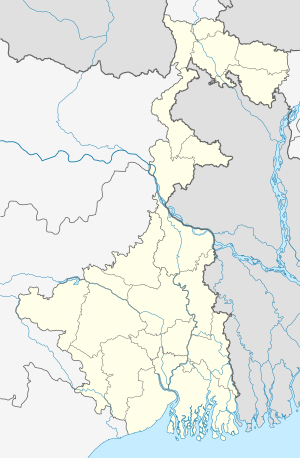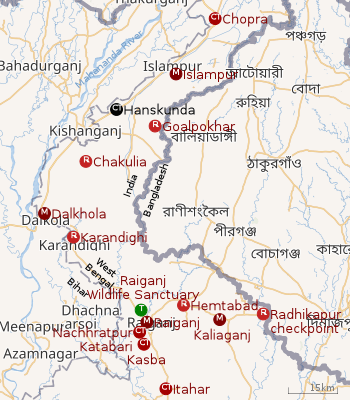Hanskunda
Hanskunda is a census town in Goalpokhar I CD Block in Islampur subdivision of Uttar Dinajpur district in the state of West Bengal, India.
Hanskunda | |
|---|---|
Census Town | |
 Hanskunda Location in West Bengal, India  Hanskunda Hanskunda (India) | |
| Coordinates: 26.1492°N 88.0367°E | |
| Country | |
| State | West Bengal |
| District | Uttar Dinajpur |
| Population (2011) | |
| • Total | 5,939 |
| Languages | |
| • Official | Bengali, English, Urdu |
| Time zone | UTC+5:30 (IST) |
| Vehicle registration | WB |
| Lok Sabha constituency | Raiganj |
| Vidhan Sabha constituency | Goalpokhar |
| Website | uttardinajpur |
Geography
 |
| Cities and towns in the Uttar Dinajpur district M: municipal city/ town, CT: census town, R: rural/ urban centre, T: tourist centre Owing to space constraints in the small map, the actual locations in a larger map may vary slightly |
Location
Hanskunda is located at 26.1492°N 88.0367°E Hanskunda is not marked in Google maps. It is shown in the District Census Handbook.[1]
In the map alongside, all places marked on the map are linked in the full screen version.
Demographics
As per the 2011 Census of India, Hanskunda had a total population of 5,939, of which 3,065 (52%) were males and 2,874 (48%) were females. Population below 6 years was 975. The total number of literates in Hanskunda was 3,219 (64.85% of the population over 6 years).[2]
Official languages
As per the West Bengal Official Language (Amendment) Act, 2012, which came into force from December 2012, Urdu was given the status of official language in areas, such as subdivisions and blocks, having more than 10% Urdu speaking population.[3]In Uttar Dinajpur district, Goalpokhar I and II blocks, Islampur block and Islampur municipality were identified as fulfilling the norms set[4]In 2014, Calcutta High Court, in an order, included Dalkhola municipality in the list.[5]
Transport
National Highway 27 passes through Hanskunda and Panjipara railway station is located nearby.[1]
References
- "District Census Handbook Uttar Dinajpur, Series 20, Part XII A" (PDF). Map of Goalpokhar I CD block on page 173. Directorate of Census Operations, West Bengal. Retrieved 9 January 2019.
- "C.D. Block Wise Primary Census Abstract Data(PCA)". West Bengal – District-wise CD Blocks. Registrar General and Census Commissioner, India. Retrieved 9 January 2019.
- "Minority Affairs and Madrasah Education". Chief Minister’s Office, Government of West Bengal. Retrieved 14 January 2019.
- "Bengal gives second language status to Urdu". Zee News, 4 February 2012. Retrieved 14 January 2019.
- "Santosh Chowdhury and Ors Vs State of West Bengal and ors". Indian Kanoon. Retrieved 14 January 2019.